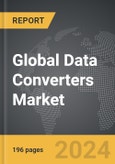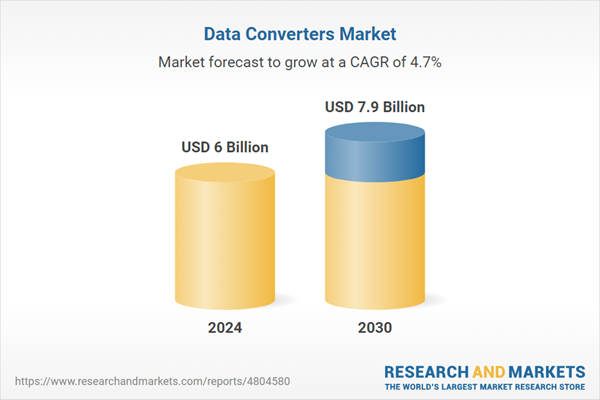The global market for Data Converters was valued at US$6.0 Billion in 2024 and is projected to reach US$7.9 Billion by 2030, growing at a CAGR of 4.7% from 2024 to 2030. This comprehensive report provides an in-depth analysis of market trends, drivers, and forecasts, helping you make informed business decisions. The report includes the most recent global tariff developments and how they impact the Data Converters market.
Segments: Type (Analog-to-Digital Converter, Digital-to-Analog Converter).
Geographic Regions/Countries: World; United States; Canada; Japan; China; Europe (France; Germany; Italy; United Kingdom; and Rest of Europe); Asia-Pacific; Rest of World.
The analysts continuously track trade developments worldwide, drawing insights from leading global economists and over 200 industry and policy institutions, including think tanks, trade organizations, and national economic advisory bodies. This intelligence is integrated into forecasting models to provide timely, data-driven analysis of emerging risks and opportunities.
Global Data Converters Market - Key Trends and Drivers Summarized
What Are Data Converters and How Do They Function Within Modern Technologies?
Data converters are essential components that facilitate the interaction between analog and digital environments by converting signals from analog to digital (ADC) and from digital to analog (DAC). These devices are crucial in a myriad of applications across various sectors, including telecommunications, audio processing, and medical imaging, where they enable the seamless conversion of real-world analog signals, such as sound and light, into digital formats that can be processed by electronic systems, and vice versa. ADCs convert analog signals into a digital form that computers can understand, a process essential for digital signal processing. DACs, on the other hand, are used to convert digital signals back into analog form, enabling digital data to be utilized by analog devices. This bidirectional conversion is critical for the functionality of consumer electronics, industrial machinery, and automotive systems, where precision and accuracy in signal conversion are paramount for system performance and reliability.Why Is Precision in Data Conversion Critical to Industry and Consumer Applications?
The precision of data converters directly impacts the accuracy and quality of signal processing applications, making high-precision data converters indispensable in fields such as medical instrumentation, high-fidelity audio equipment, and precision measurement instruments. In medical applications, for example, ADCs are used to convert the analog signals gathered by sensors monitoring vital signs into digital data that can be analyzed to make diagnostic decisions. Similarly, in audio systems, DACs ensure that digital sound is accurately converted into analog signals, preserving sound quality across various playback devices. The demand for high-resolution and low-noise data converters is driven by the need for detailed and accurate data in these applications, where even minor discrepancies in conversion can lead to significant errors in output or interpretation.How Are Innovations and Technologies Advancing Data Converter Capabilities?
Recent innovations in semiconductor technology and digital processing have significantly enhanced the capabilities of data converters, making them faster, more accurate, and more energy-efficient. Developments in integrated circuit design have led to the creation of more compact and power-efficient converters that can perform at higher speeds without compromising accuracy. For instance, the advent of Sigma-Delta modulation in ADCs has enabled higher resolutions in digital audio recording, improving sound quality and system fidelity. Additionally, the integration of machine learning algorithms with data conversion processes is beginning to emerge as a trend, with algorithms that can dynamically adjust conversion parameters in real-time to optimize performance and efficiency based on the application's needs. These technological advancements are crucial in meeting the increasingly stringent requirements of modern electronic systems across a diverse array of industries.What Drives the Growth in the Data Converters Market?
The growth in the data converters market is driven by several factors, reflecting a blend of technological, economic, and consumer-driven demands. The continuous advancement in consumer electronics, automotive electronics, and telecommunication systems, which require robust data conversion to function effectively, propels the need for innovative data converter solutions. As devices become smarter and more connected, the role of ADCs and DACs becomes increasingly critical in providing the necessary interface between digital controllers and the analog world. Furthermore, the expansion of the Internet of Things (IoT) and the proliferation of devices that monitor, control, and communicate through digital and analog signals boost the demand for data converters. The push towards automotive electrification and the adoption of advanced driver-assistance systems (ADAS) also create substantial opportunities for the application of sophisticated data converters. Lastly, the growing emphasis on making devices more power-efficient and capable of handling higher data rates continues to spur developments in data converter technology, fueling growth in the market. These drivers ensure that data converters remain at the forefront of technological innovation, meeting the demands of an increasingly digital and connected world.Report Scope
The report analyzes the Data Converters market, presented in terms of units. The analysis covers the key segments and geographic regions outlined below.Segments: Type (Analog-to-Digital Converter, Digital-to-Analog Converter).
Geographic Regions/Countries: World; United States; Canada; Japan; China; Europe (France; Germany; Italy; United Kingdom; and Rest of Europe); Asia-Pacific; Rest of World.
Key Insights:
- Market Growth: Understand the significant growth trajectory of the Analog-to-Digital Converter segment, which is expected to reach US$4.9 Billion by 2030 with a CAGR of a 5.5%. The Digital-to-Analog Converter segment is also set to grow at 3.5% CAGR over the analysis period.
- Regional Analysis: Gain insights into the U.S. market, valued at $1.6 Billion in 2024, and China, forecasted to grow at an impressive 4.4% CAGR to reach $1.2 Billion by 2030. Discover growth trends in other key regions, including Japan, Canada, Germany, and the Asia-Pacific.
Why You Should Buy This Report:
- Detailed Market Analysis: Access a thorough analysis of the Global Data Converters Market, covering all major geographic regions and market segments.
- Competitive Insights: Get an overview of the competitive landscape, including the market presence of major players across different geographies.
- Future Trends and Drivers: Understand the key trends and drivers shaping the future of the Global Data Converters Market.
- Actionable Insights: Benefit from actionable insights that can help you identify new revenue opportunities and make strategic business decisions.
Key Questions Answered:
- How is the Global Data Converters Market expected to evolve by 2030?
- What are the main drivers and restraints affecting the market?
- Which market segments will grow the most over the forecast period?
- How will market shares for different regions and segments change by 2030?
- Who are the leading players in the market, and what are their prospects?
Report Features:
- Comprehensive Market Data: Independent analysis of annual sales and market forecasts in US$ Million from 2024 to 2030.
- In-Depth Regional Analysis: Detailed insights into key markets, including the U.S., China, Japan, Canada, Europe, Asia-Pacific, Latin America, Middle East, and Africa.
- Company Profiles: Coverage of players such as Analog Devices, Inc., Asahi Kasei Microdevices Corporation, Avia Semiconductor (Xiamen) Co., Ltd., Cirrus Logic, Inc., Datel and more.
- Complimentary Updates: Receive free report updates for one year to keep you informed of the latest market developments.
Some of the 46 companies featured in this Data Converters market report include:
- Analog Devices, Inc.
- Asahi Kasei Microdevices Corporation
- Avia Semiconductor (Xiamen) Co., Ltd.
- Cirrus Logic, Inc.
- Datel
- Faraday Technology Corporation
- Intersil, a Renesas Company
- IQ-Analog
- Maxim Integrated Products, Inc.
- Microchip Technology, Inc.
- NXP Semiconductors NV
- ON Semiconductor Corporation
- ROHM Co., Ltd.
- STMicroelectronics NV
- Texas Instruments, Inc.
Tariff Impact Analysis: Key Insights for 2025
Global tariff negotiations across 180+ countries are reshaping supply chains, costs, and competitiveness. This report reflects the latest developments as of April 2025 and incorporates forward-looking insights into the market outlook.The analysts continuously track trade developments worldwide, drawing insights from leading global economists and over 200 industry and policy institutions, including think tanks, trade organizations, and national economic advisory bodies. This intelligence is integrated into forecasting models to provide timely, data-driven analysis of emerging risks and opportunities.
What’s Included in This Edition:
- Tariff-adjusted market forecasts by region and segment
- Analysis of cost and supply chain implications by sourcing and trade exposure
- Strategic insights into geographic shifts
Buyers receive a free July 2025 update with:
- Finalized tariff impacts and new trade agreement effects
- Updated projections reflecting global sourcing and cost shifts
- Expanded country-specific coverage across the industry
Table of Contents
I. METHODOLOGYII. EXECUTIVE SUMMARY2. FOCUS ON SELECT PLAYERSIII. MARKET ANALYSISIV. COMPETITION
1. MARKET OVERVIEW
3. MARKET TRENDS & DRIVERS
4. GLOBAL MARKET PERSPECTIVE
UNITED STATES
CANADA
JAPAN
CHINA
EUROPE
FRANCE
GERMANY
ITALY
UNITED KINGDOM
REST OF EUROPE
ASIA-PACIFIC
REST OF WORLD
Companies Mentioned (Partial List)
A selection of companies mentioned in this report includes, but is not limited to:
- Analog Devices, Inc.
- Asahi Kasei Microdevices Corporation
- Avia Semiconductor (Xiamen) Co., Ltd.
- Cirrus Logic, Inc.
- Datel
- Faraday Technology Corporation
- Intersil, a Renesas Company
- IQ-Analog
- Maxim Integrated Products, Inc.
- Microchip Technology, Inc.
- NXP Semiconductors NV
- ON Semiconductor Corporation
- ROHM Co., Ltd.
- STMicroelectronics NV
- Texas Instruments, Inc.
Table Information
| Report Attribute | Details |
|---|---|
| No. of Pages | 196 |
| Published | April 2025 |
| Forecast Period | 2024 - 2030 |
| Estimated Market Value ( USD | $ 6 Billion |
| Forecasted Market Value ( USD | $ 7.9 Billion |
| Compound Annual Growth Rate | 4.7% |
| Regions Covered | Global |









